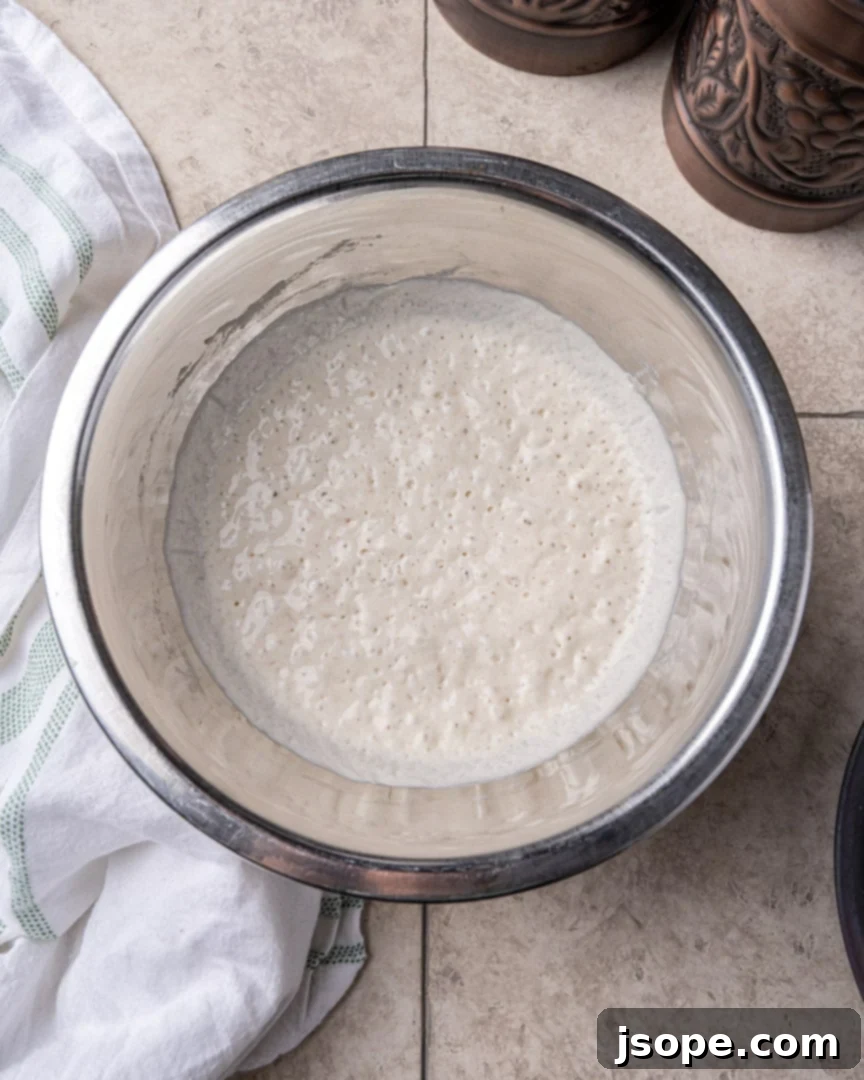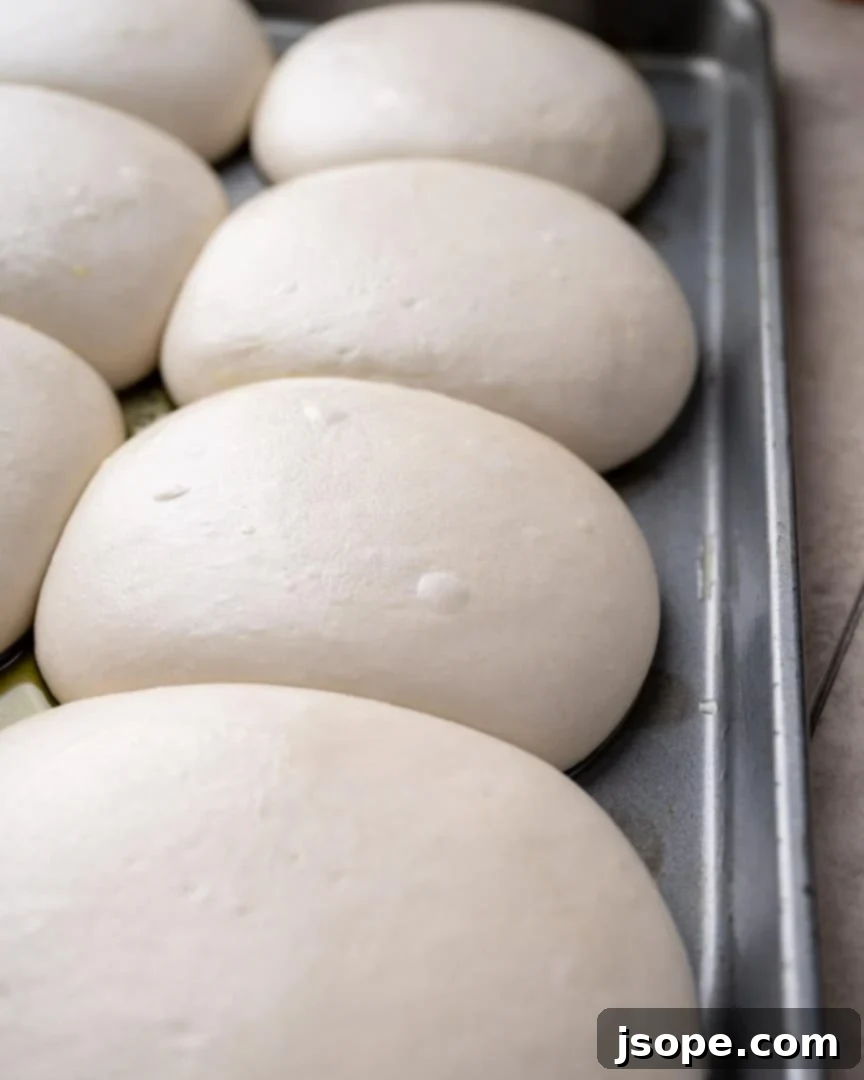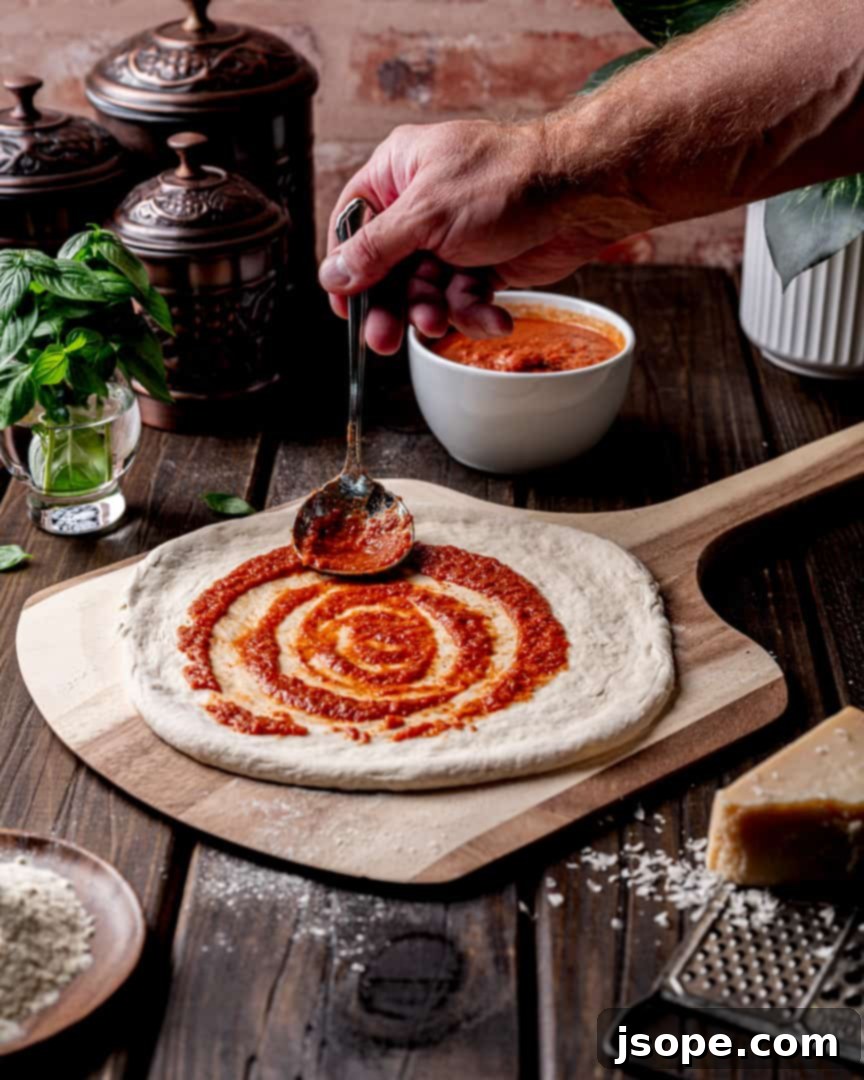Welcome to the ultimate guide for crafting the perfect homemade Neapolitan pizza crust! If you’ve been dreaming of that distinctively light, airy texture, adorned with those characteristic large bubbles and a delightful chew, your search ends here. This comprehensive recipe shares our time-tested method for achieving authentic Neapolitan pizza dough right in your kitchen, using just a few high-quality ingredients.

The foundation of any truly great pizza lies in its crust. A superior dough isn’t just an accessory; it’s the very soul of the pizza, providing the perfect canvas for your favorite toppings. Having savored countless pizzas across the globe, we understand the critical role dough plays. That’s why we meticulously developed this recipe to deliver an unparalleled Neapolitan-style pizza experience in the comfort of your home.
For those who share our passion for authentic Italian cuisine, we invite you to explore our wider collection of Classic Italian Recipes. From mastering Homemade Pasta to indulging in a creamy Lemon Cream Gelato, we bring the flavors of Italy straight to your table.
The Distinctive Charm of Neapolitan Pizza Dough
In the vast universe of pizza styles, Neapolitan pizza consistently reigns supreme for its unique characteristics. But what truly sets this dough apart from its counterparts? The best way to describe it is by highlighting what it is *not*. It’s not overly “bready” like some American styles, nor is it thin and cracker-like crunchy. Instead, an authentic Neapolitan crust boasts a remarkable interplay of textures: delightfully crisp on the outside, yet wonderfully airy and light on the inside, with a satisfying, tender chew.
A hallmark of Neapolitan pizza is its irregular, puffy rim, known as the “cornicione.” This crust develops beautiful, large air bubbles during baking, often displaying a slight char, which adds depth of flavor. While the center of a Neapolitan pizza is generally thin, perhaps even delicate, the outer crust is notably tall and thick, a testament to its airy structure. This crucial combination of a slight crispness at the surface with an underlying soft, pliable chew is what defines the “crisp chew” texture, making Neapolitan pizza an unforgettable culinary experience.
Understanding Poolish: The Secret to Superior Neapolitan Pizza Dough
The use of a “poolish” in Neapolitan pizza dough is widely regarded as a not-so-secret weapon that elevates every aspect of the finished pizza. A poolish is essentially a pre-ferment, a type of starter that is prepared in advance. Our method involves making the poolish the day before (typically 10-15 hours prior), allowing it to become incredibly active and vibrant. When integrated into the main dough, this highly active poolish supercharges the fermentation process, imparting several crucial benefits:
- **Enhanced Texture:** The poolish significantly contributes to the dough’s distinctive chewy-crispness, ensuring that ideal balance between a delicate exterior and a tender interior. It promotes the formation of those coveted large air pockets within the crust.
- **Deeper Flavor:** Fermentation in the poolish develops complex flavor compounds, adding a subtle tanginess reminiscent of a very mild sourdough. This depth of flavor is difficult to achieve with a direct dough method.
- **Signature Bubbles:** The extended fermentation of the poolish is key to developing the high activity necessary for those characteristic large, irregular bubbles in the Neapolitan crust, which contribute to its light and airy structure.
Making a poolish is surprisingly simple. It’s a very wet mixture, distinct from the final dough, consisting only of yeast, water, and flour. It takes mere minutes to combine these ingredients, and then it simply rests at room temperature overnight, doing its magical work. This small, extra step is absolutely worth the effort for the incredible impact it has on your pizza dough.

Essential Ingredients for Your Neapolitan Pizza Dough
Our Neapolitan Pizza Dough Recipe relies on a carefully selected range of simple, yet high-quality ingredients, each playing a vital role in achieving the perfect crust:
For the Poolish:
- Dry Yeast: We highly recommend using Italian dry yeast, such as Caputo brand yeast, specifically formulated for pizza making. A small quantity is used, allowing for a slow, overnight fermentation that develops rich flavors and optimal dough activity.
- Tipo “00” Flour: Often labeled “pizza flour,” Tipo “00” flour is incredibly finely milled and has a low protein content, which is crucial for producing the characteristic delicate, soft, and elastic texture of Neapolitan pizza, pasta, and focaccia. Our preferred choice is this Italian Tipo “00” flour brand.
- Cold Water: Using cold water (around 40°F) for the poolish helps to slow down the initial yeast activity, allowing for a longer, more controlled fermentation overnight, which is essential for flavor development.
For the Main Dough:
- Dry Yeast: The same high-quality Italian dry yeast used for the poolish is incorporated into the main dough mixture to ensure consistent fermentation.
- Granulated Sugar: A minimal amount of granulated white sugar serves as readily available food for the yeast, helping to kickstart its activity quickly and efficiently.
- Warm Water: The warm water for the main dough should be approximately 85°F. It’s important to avoid temperatures exceeding 110°F, as this can unfortunately kill the active yeast, hindering dough development.
- Tipo “00” Flour: Again, using authentic Italian Tipo “00” flour is key to achieving the desired texture. While any Tipo “00” flour will work, consistency with the brand used for the poolish is often beneficial.
- Ice-Cold Water: Incorporating ice-cold water into the main dough helps to control the overall dough temperature, preventing it from overheating during mixing and ensuring a slow, controlled rise.
- The Poolish: The star of the show! The pre-fermented poolish adds significant depth of flavor, improved texture, and those beautiful air bubbles.
- Kosher Salt: Essential for seasoning the dough, salt also plays a critical role in controlling yeast activity and strengthening the gluten structure.
- Extra Virgin Olive Oil: A touch of high-quality extra virgin olive oil enhances both the flavor and texture of the dough, contributing to a more tender crumb and a richer aroma.
Please refer to the detailed recipe card below for precise quantities and measurements.
Thoughtful Ingredient Substitutions
While we highly recommend the specified ingredients for the most authentic Neapolitan experience, here are a few common substitutions that will still yield excellent results:
- Tipo “00” Flour Alternative: If Tipo “00” flour is unavailable, all-purpose flour or bread flour can be used. Be aware that these flours have a higher protein content and may result in a slightly denser crust compared to the delicate texture achieved with Tipo “00”, but the recipe will still function effectively.
- Yeast Alternatives: Instant yeast or active dry yeast can be successfully substituted for Italian pizza yeast in both the poolish and the main dough. If using active dry yeast, you may need to activate it in warm water before combining with other ingredients.
- Sugar Alternative: Honey can be used in place of granulated sugar in the final dough mixture, offering a subtle sweetness and helping to activate the yeast.
Crafting Your Neapolitan Pizza Dough: A Step-by-Step Guide
Making this Neapolitan pizza dough is not inherently difficult, but it does require patience and adherence to proper dough preparation techniques. Once prepared, this recipe yields eight perfectly sized dough balls, each capable of creating approximately a 12-inch pizza.
Essential Equipment for Dough Preparation
Having the right tools can significantly simplify the dough-making process:
- Stand Mixer with a Dough Hook: Highly recommended for efficient and consistent kneading, ensuring proper gluten development. Alternatively, the dough can be mixed and kneaded by hand until it forms a smooth, cohesive ball, though this requires more effort.
- Bench Scraper: An indispensable tool for cleanly handling and maneuvering the slightly sticky dough, making division and shaping much easier.
- Rubber Spatula: Useful for mixing the poolish and scraping down the sides of bowls.
- Pizza Peel: Crucial for shaping your pizza and, more importantly, for easily and safely transferring it into and out of a hot oven.
Detailed Instructions for Neapolitan Pizza Dough
Step 1: Prepare the Poolish
- The poolish is a simple three-ingredient mixture. In a bowl, combine the yeast and cold water, allowing it to rest for about 5 minutes. Then, stir in the Tipo “00” flour with a rubber spatula until a very thick, wet batter forms. Once mixed, cover the bowl tightly with plastic wrap and let it ferment at room temperature overnight, ideally for 10-15 hours. This extended period allows the yeast to work its magic, developing deep flavors and active fermentation.

Step 2: Mix and Develop the Main Dough
- Begin by combining the yeast, sugar, and warm water in a small bowl. Let this mixture sit for approximately 15 minutes to fully hydrate the yeast and allow it to begin blooming.
- Next, in the bowl of your stand mixer fitted with a dough hook, add the Tipo “00” flour. Gradually add most of the ice-cold water, reserving about half a cup. Pour in the activated yeast mixture. Use the reserved ice water to rinse out any remaining yeast from its bowl and add it to the mixer. Mix on low speed for about a minute until the ingredients start to come together. Now, add the prepared poolish and continue mixing for another minute, periodically pulling the dough off the hook as it develops.
- Once the dough begins to form, add the kosher salt and olive oil. Continue mixing for 5-10 minutes until the dough forms a cohesive ball around the dough hook and detaches cleanly from the sides of the bowl. The dough will still feel somewhat sticky to the touch, but it should have developed sufficient gluten structure. If it remains excessively sticky, add flour one tablespoon at a time until it comes together.
- Turn the dough out onto a clean, unfloured work surface. Briefly knead it by hand to form a smooth ball. Transfer this dough ball to a large, clean bowl that has been lightly oiled. Cover the bowl with a damp tea towel or plastic wrap and allow the dough to proof at room temperature for 30 minutes. This initial rest helps the gluten relax.
- After 30 minutes, gently remove the dough from the bowl onto a clean work surface (no additional flour needed). Divide the dough into eight equal pieces, each weighing approximately 8.5 ounces (235g). Shape each piece into a tight dough ball. This is done by folding the sides of each piece into its center, then flipping the ball over and using cupped hands to roll it against the work surface in small circles, creating surface tension and a smooth, taut ball.
- Place the shaped dough balls on a lightly oiled baking sheet, ensuring the tops are also subtly coated with oil to prevent drying. Cover the baking sheet tightly with plastic wrap and transfer it to the refrigerator.

Step 3: Cold Proofing for Enhanced Flavor and Texture
- The dough balls should proof in the refrigerator for at least one hour. However, for truly exceptional flavor and texture, we strongly recommend a cold proofing period of at least 12 hours, and ideally up to 24-48 hours. This slow, cold fermentation allows for maximum flavor development and creates a more manageable, extensible dough. Remember to bring the dough balls back to room temperature for about 15-30 minutes before you intend to shape and cook your pizzas. This makes them much easier to work with.
Step 4: Prepare the Oven and Expertly Shape Your Pizza
- Preheat your oven with a pizza stone inside to its highest possible setting (typically 550°F), using convection if available. Allow it to preheat for a minimum of 30 minutes to ensure the stone is thoroughly hot. For an extra boost of heat, switch the oven to broiler mode for 5 minutes, then return it to 550°F convection just before loading your pizza.
- To begin shaping your pizza crust, prepare two small bowls: one with all-purpose flour and another with semolina flour (regular flour can be used if semolina is unavailable). Remove a dough ball from the plastic wrap and dredge it thoroughly in the all-purpose flour, coating all sides.
- Lightly dust your pizza peel or a suitable board with a small amount of semolina flour. Place the floured dough ball onto the peel.
- Start shaping by gently pressing down on the center of the dough with your fingertips, working outwards towards the edges. This technique pushes the air towards the rim, creating that signature fluffy cornicione. Avoid pressing too hard on the very edges to preserve the air bubbles. The outer crust will expand to about 3-4 times the thickness of the center. Once flattened, lift the dough and use your knuckles to gently stretch it, rotating as you go, until it reaches your desired size and thickness (typically 10-12 inches for this recipe). **Crucially, never use a rolling pin**, as this will deflate all the precious air bubbles and result in a flat, dense crust.

Step 5: Cook Your Perfect Pizza
- Once your dough is shaped and topped with your desired ingredients, carefully slide the pizza directly onto the preheated pizza stone in the oven. Bake for approximately 5-6 minutes, or until the crust is beautifully bubbled, golden brown, and slightly charred in spots. For an extra crispy top and blistered crust, turn on the broiler for the last 45-60 seconds, watching carefully to prevent burning.
- Once cooked to perfection, remove the pizza from the oven and transfer it to a wire rack for a few minutes. This allows steam to escape from the bottom, preventing a soggy crust. Finally, move it to a cutting board, slice, and serve immediately to enjoy its fresh, authentic flavors!

Alternative Cooking Methods for Neapolitan Style Pizza
While the detailed instructions above are tailored for a conventional home oven (which most people have access to), this versatile Neapolitan dough excels in various other cooking environments. Its robust structure and flavor development make it suitable for any pizza oven, from traditional wood-fired ovens that reach extreme temperatures to modern countertop pizza appliances designed for high heat.
For those who enjoy outdoor cooking, grilling your pizza is also an excellent option. Simply place the shaped and topped pizza directly onto lightly oiled grill grates, close the lid, and cook. Since every grill behaves differently, pay close attention to the heat distribution, utilizing both direct and indirect heat as needed to achieve an evenly cooked crust without burning. A grill stone can also be used for a more even cook.
Creative Flavor Variations for Your Dough
While this Neapolitan pizza dough is incredibly delicious on its own, a touch of creativity can introduce exciting new flavor dimensions. Remember that a little goes a long way when infusing the dough itself:
- Aromatic Herbs: Incorporate finely chopped fresh herbs like oregano, rosemary, marjoram, thyme, or sage directly into the dough during the mixing stage. Dried herbs can also be used, but in smaller quantities. These additions impart subtle fragrant notes that complement various toppings.
- Cracked Black Pepper: A generous crack of fresh black pepper adds a delightful piquancy and character to the dough, particularly good with cheese-based pizzas.
- Infused Olive Oils: Substitute the regular extra virgin olive oil in the recipe with a garlic-infused or herb-infused olive oil. This simple swap introduces complex aromatic undertones throughout the crust, enhancing both flavor and texture.
Storage and Freezing Guidelines for Pizza Dough
Proper storage is key to preserving the quality of your homemade Neapolitan pizza dough:
Refrigeration: Uncooked pizza dough balls, lightly oiled and tightly covered with plastic wrap, can be stored in the refrigerator for up to 3 days. Beyond this period, the dough may overproof and become “tired” or saggy, losing its characteristic elasticity and structure. Always allow refrigerated dough to come to room temperature for 15-30 minutes before shaping.
Freezing for Long-Term Storage: For longer storage, pizza dough freezes beautifully. Simply take the prepared dough balls from the refrigerator, wrap each one individually in several layers of plastic wrap to prevent freezer burn, and then place them in an airtight freezer bag or container. Frozen dough balls can be stored for up to 3 months. When you’re ready to use them, transfer the frozen dough balls to the refrigerator to defrost slowly overnight or for at least 8-12 hours. If you plan to use them on the same day, allow them to defrost completely at room temperature, which may take several hours. Once defrosted, use the dough within 3 days for best results, ensuring it comes to room temperature before shaping.
Troubleshooting Common Pizza Dough Issues
Even experienced pizza makers encounter challenges. Here are solutions to some common issues:
- Soggy Pizza Center: If your pizza’s center is soggy after cooking, excess moisture from your sauce or mozzarella is usually the culprit. To remedy this, strain any extra liquid from your pizza sauce using a fine sieve. For fresh mozzarella, gently pat away any excess moisture with paper towels before placing it on your pizza. This simple step makes a significant difference.
- Oven Not Hot Enough: Authentic Neapolitan pizza is typically baked at extremely high temperatures (800°-1000°F) in professional pizza ovens. While home ovens can’t reach these extremes, you can still achieve excellent results by maximizing your oven’s heat. We highly recommend using a pizza stone. Preheat your oven to its highest temperature (ours reaches 550°F convection) with the stone inside for at least 30 minutes. Then, switch to the broiler setting for 5 minutes to superheat the stone further, returning to 550°F convection right before inserting the pizza. This method allows our pizzas to cook perfectly in about 5-6 minutes, often with a final minute under the broiler to achieve a beautifully blistered top crust.

The Simplicity of Authentic Neapolitan Pizza Sauce
True Neapolitan pizza sauce is defined by its elegant simplicity. Traditionally, it consists of just a few pristine ingredients: crushed San Marzano tomatoes, a pinch of salt, and often fresh basil. Crucially, authentic Neapolitan sauces are *never* cooked prior to baking, as they will heat and meld beautifully with the pizza in the high-temperature oven, preserving the fresh, vibrant flavor of the tomatoes.
For a perfect complement to your homemade Neapolitan pizza, explore our Quick and Easy No-Cook Pizza Sauce Recipe – it’s designed to let the incredible flavor of your dough shine!
Expand Your Palette: More Delicious Pizza Sauce Recipes
Rich Red Sauce for Pizza
If time allows and you desire a deeply flavored Italian pizza sauce, our recipe for The Best Homemade Pizza Sauce is a must-try. This sauce is slow-cooked for several hours, allowing the flavors of ripe tomatoes, sweet onions, and aromatic herbs to concentrate into an exquisitely tasty and robust sauce.
Vibrant Pesto Sauce
While not strictly traditional, using pesto as a pizza sauce base offers a fantastic burst of fresh flavor. We adore our Quick and Delicious Homemade Basil Pesto Recipe as an unexpected, yet delightful, foundation for your next pizza creation!
Elegant White Pizza Sauce (Pizza Bianca)
For a delightful change from classic red sauce, a white pizza (Pizza Bianca) is a superb choice. Our Garlic White Sauce provides an amazing base, pairing beautifully with a variety of toppings, from earthy mushrooms to vibrant fresh summer vegetables.
The Beauty of Naked Pizza
Sometimes, the ultimate way to appreciate the exceptional flavor of Neapolitan pizza dough is to forego sauce entirely. A “naked pizza” simply features toppings and a generous drizzle of high-quality extra virgin olive oil after baking, allowing the nuanced taste and texture of the dough to truly shine through as the star of the show.
Selecting the Perfect Toppings for Neapolitan Pizza
The iconic Margherita pizza stands as the most beloved and traditional expression of Neapolitan pizza. It features a simple tomato-based sauce, fresh mozzarella (often buffalo milk mozzarella), and fresh basil leaves added just as it emerges from the oven. A final flourish might include a drizzle of premium extra virgin olive oil, a sprinkle of freshly grated Parmigiano Reggiano or Pecorino Romano, and perhaps a touch of crushed red pepper flakes for a subtle kick.
While Neapolitan tradition in Italy favors a minimalist approach to toppings, allowing the high-quality dough and sauce to be the focus, your homemade pizza is your canvas! Feel free to experiment with your favorite additions, from savory sausages and salami to vibrant bell peppers, onions, olives, or even anchovies. Just remember that less is often more to truly appreciate the delicate balance of flavors in an authentic Neapolitan pizza.

Looking for more inspired pizza topping ideas? Here are a few favorite recipes from our blog:
- Goat Cheese Pesto and Asparagus Pizza
- Truffle Mushroom White Pizza
- Stuffed Squash Blossom and Zucchini White Pizza
Wine Pairings for Your Neapolitan Pizza
While many Italians traditionally enjoy beer with their pizza, we find that a carefully selected glass of wine can beautifully complement the flavors of Neapolitan-style pizzas. Here are some of our top wine recommendations:
For red sauce pizzas, you’ll be hard-pressed to go wrong with a classic pairing. Our personal favorites include a robust Barolo or an elegant Chianti Classico, both offering structure and acidity to cut through the richness of the sauce and cheese. Primitivo (Zinfandel) is another excellent choice, with its fruit-forward profile. And for a lighter red, a Pinot Noir (often dubbed “pizza & pinot”) is always a fantastic, versatile pick.
When opting for white sauce or a sauceless pizza, reach for a white wine with bright acidity. Pinot Grigio or Sauvignon Blanc are perfect choices, offering crispness that balances the richness of the cheese and other toppings. Rosé wines can also be a delightful accompaniment, provided they are dry. Italian rosés and those from Provence, France, are particularly well-suited, offering a refreshing and harmonious pairing.
Top Tips for Neapolitan Pizza Perfection
- Plan Ahead for Flavor: The quality of your Neapolitan pizza dough significantly improves with time. While delicious after an hour of cold proofing, allowing the dough to cold-proof in the refrigerator for 6-12 hours, or even longer, will dramatically enhance its flavor complexity and texture. The extended, slow fermentation develops deeper, more nuanced tastes that are characteristic of authentic Neapolitan pizza.
- Ensure a Crispy Base: After removing your freshly baked pizza from the oven, resist the urge to immediately transfer it to a solid cutting board. Instead, place it on a wire cooling rack for a couple of minutes. This crucial step allows steam to escape from the very hot crust, preventing moisture from accumulating and ensuring the bottom of your pizza remains wonderfully crisp, not soggy.
Frequently Asked Questions About Neapolitan Pizza Dough
While both are beloved, significant differences distinguish Neapolitan from New York style pizza. Neapolitan pizza typically uses fresh mozzarella, often thinly sliced or torn, and a more minimalistic approach to toppings and sauce. New York style often features shredded mozzarella and a more generous application of ingredients. Texturally, Neapolitan dough is known for its blistered, chewy, and airy crust (the cornicione), whereas New York style tends to be larger, thinner, and more foldable, with a less pronounced, often crispier, uniform crust.
Tipo “00” flour is universally recognized as the classic and superior choice for authentic Neapolitan pizza dough. Its fine milling and low protein content create the ideal delicate, elastic texture.
Neapolitan pizza is generally considered a thin-crust pizza, particularly in the center. However, it is not uniformly thin; its distinctive feature is the puffed-up, airy, and often blistered outer crust, known as the cornicione, which is quite tall and thick due to large internal air bubbles.
Homemade pizza dough can be stored in the refrigerator for up to three days. For longer preservation, it can be frozen for up to three months. Beyond these times, the dough’s quality and characteristics may degrade.
While the main dough doesn’t strictly *need* to rest overnight (it can be cold-proofed for as little as an hour), an overnight rest, ideally 12 hours or more of cold proofing, significantly enhances the dough’s flavor and texture. The poolish component of this recipe, however, *must* be made a day in advance, making the entire process at least 11 hours long even at a minimum.
Related Recipes to Inspire Your Italian Cooking Journey
If you enjoyed this recipe, explore these other delightful Italian-inspired dishes:
- Homemade Butternut Squash Ravioli Recipe
- Italian Herb Sautéed Zucchini Squash Recipe
- Garlic Herb Sautéed Italian Eggplant Recipe
- Pan Fried Risotto Cakes – Easy Leftover Risotto Recipe
Perfect Pairings: Cocktails to Enjoy with Your Pizza
Elevate your pizza night with these delightful cocktail pairings:
- Spiced Cranberry Old Fashioned Cocktail Recipe
- Shimmy Shimmy Coconut Basil Lime Gin Cocktail
- Spiced Apple Cider Moscow Mule Cocktail Recipe
- Fig Cardamom Gin Old Fashioned Cocktail
Neapolitan Pizza Dough Recipe for the Perfect Crust
Make authentic Neapolitan-style pizza dough with the perfect light and airy crust at home with just a few ingredients!
5 out of 5 stars (based on 1 vote)
Print Recipe | Pin Recipe
| Prep Time | Cook Time | Proofing | Total Time |
|---|---|---|---|
| 30 mins | 5 mins | 11 hrs | 11 hrs 35 mins |
| Course | Cuisine | Servings | Calories |
|---|---|---|---|
| Main Course | Italian | 8 people | 599 kcal |
Equipment
- Stand Mixer with Dough Hook (recommended)
- Sheet Tray
- Pizza Peel
- Pizza Stone (recommended)
- Bench Scraper
Ingredients
For the Poolish:
- 120 g Cold Water
- 0.5 g Yeast
- 120 g Tipo “00” Flour (sifted)
For the Dough:
- 5.5 g Yeast
- 175 g Warm Water (85°F)
- 1 g Granulated Sugar
- 1160 g Tipo “00” Flour (sifted)
- 525 g Ice-Cold Water
- Poolish (from above)
- 25 g Kosher Salt
- 12.5 g Extra Virgin Olive Oil
Get ingredients with [Shopping Link Placeholder]
Instructions
Make the Poolish:
- Put the yeast and cold water in a bowl and whisk for 30 seconds. Add the sifted flour to the bowl and use a spatula to combine. It will have the texture of a thick pancake batter. Cover with plastic wrap and let sit overnight (12-20 hours is ideal).
Make the Pizza Dough (10-15 hours later):
- Refrigerate the poolish for 30 minutes before adding it to the dough recipe.
- Add the yeast to a small bowl, then add the warm water and sugar. Whisk for 30 seconds and let sit for 5 minutes.
- Add the flour to the bowl of a stand mixer with a dough hook. On low speed, add most of the ice-cold water, reserving about ½ of a cup. Next, add the yeast and water mixture. Use the reserved ice-cold water to get the rest of the yeast mixture from the bowl and add it to the flour. Mix for about a minute, then add the poolish. Mix for another minute, pulling the dough down off the hook as needed.
- Add the salt and mix for another minute. Scrape the sides of the bowl and pull the dough from the hook. Add the oil and mix for another couple of minutes until the dough forms a ball around the dough hook and no longer sticks to the walls of the bowl. The dough will be sticky to the touch but should develop enough gluten to form a ball around the hook. If your dough is still sticking to the walls add 1 tablespoon of flour and continue mixing.
- Remove the bowl from the stand mixer and slide the dough hook from the dough. The dough will be sticky, but do not add flour at this point. Using a bench scraper or your hands, do several stretch and folds in the bowl. Do this by picking up one side of the dough, stretching it up then folding it over the dough. Do this on all sides of the dough a few times until the dough ball is a bit more cohesive.
- Using extra virgin olive oil, lightly oil a large enough bowl for the dough and transfer the dough to the new bowl. Once in the bowl, do a few more stretch and folds to completely coat in the oil. Cover with a damp tea towel and let rest for 30 minutes at room temperature.
- Next, remove the dough from the bowl to a clean work surface (no floured surface necessary). Divide into eight pieces (about 8.5 oz or 235g each) and make pizza dough balls with each by folding the sides into the center of each piece of dough, flip the dough ball over, then using the work surface and cupped hands, roll the ball in circles against the work surface. Lightly oil each dough ball, and either proof in a pan covered tightly with plastic wrap or individually wrap in plastic wrap tightly, and refrigerate for at least an hour (12 is optimal) before forming into pizzas and using for best results. Remove the dough from the refrigerator for about 15-30 minutes before using.
Make Pizza Crusts
- Preheat a pizza stone in your oven at the hottest setting (usually 550°F) on convection if you have that setting, for at least 30 minutes. Then turn the broiler on for 5 minutes to get the stone even hotter. Turn it back to 550° right before putting the pizza in the oven.
- To make the pizza crust, begin by preparing a bowl of flour (all purpose is fine here) and a bowl of semolina. Remove the dough from the plastic wrap and place it in the bowl of all purpose flour and coat with flour on all sides.
- Next, sprinkle semolina onto your pizza peel and place the floured dough onto the peel. Begin by pressing dough on the center of the dough, working towards the outer edges. This will push the air to the crust to give you a nice fluffy crust around the outside of your pizza. The dough will bubble about 3-4 times the thickness of the outer edges, so push out as much of the bubbles as desired. Pick up the dough and use your knuckles while turning the dough to stretch it out to the desired size and thickness. We generally stretch these to make 10-12″ pizzas. Top your pizza with whatever toppings you want, but make sure it’s not too heavy or it won’t slide off the pizza peel onto the pizza stone.
Cook the Pizza
- Once the dough is shaped and the pizza is topped with what you want, it goes into the oven straight onto the pizza stone for about 5-6 minutes or until the crust is nice and bubbled and golden brown, then broil the pizza for another 45-60 seconds. Once done, remove from the oven and place on a wire rack for a few minutes, then transfer to a cutting board to slice and serve!
Nutrition
Calories: 599kcal | Carbohydrates: 123g | Protein: 17g | Fat: 3g | Saturated Fat: 0.5g | Polyunsaturated Fat: 1g | Monounsaturated Fat: 1g | Sodium: 1220mg | Potassium: 179mg | Fiber: 5g | Sugar: 1g | Vitamin C: 0.003mg | Calcium: 28mg | Iron: 7mg
Keyword: bread, classic Italian recipes, pizza
Tried this recipe? Let us know how it was!
Food Safety Guidelines
- Do not leave food sitting out at room temperature for extended periods.
- Never leave cooking food unattended.
For more comprehensive guidelines, please refer to the USDA.gov Food Safety Basics.
